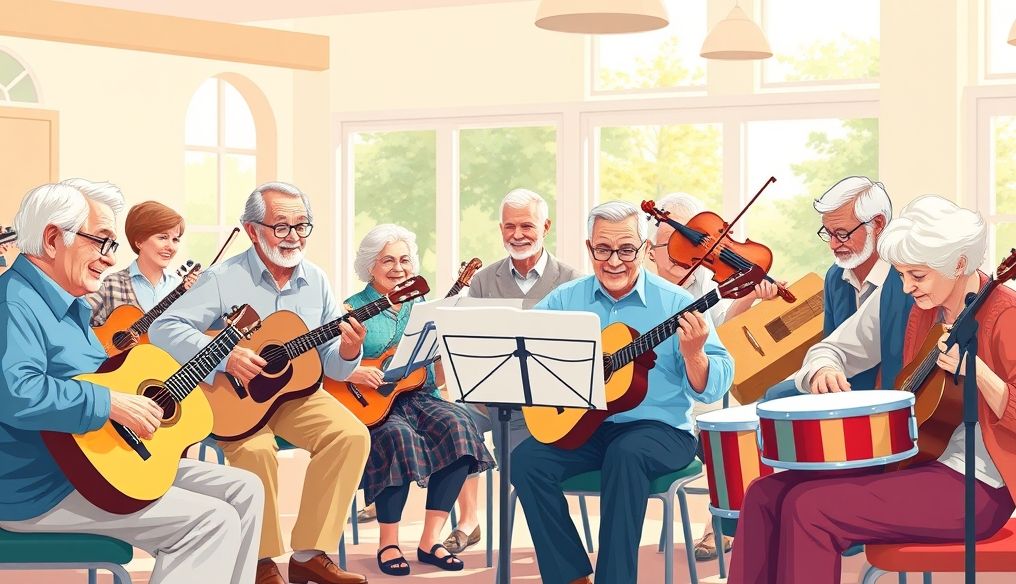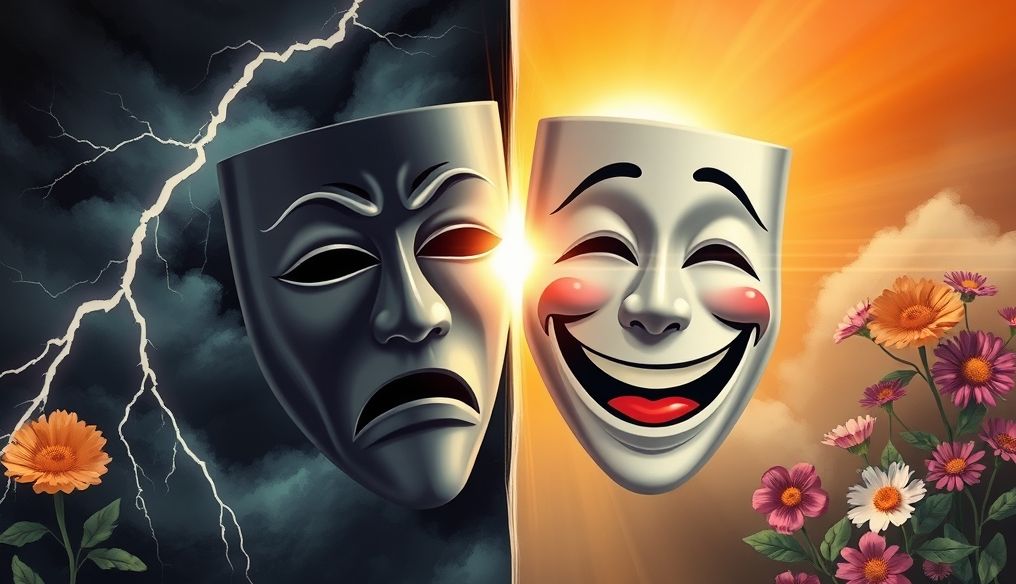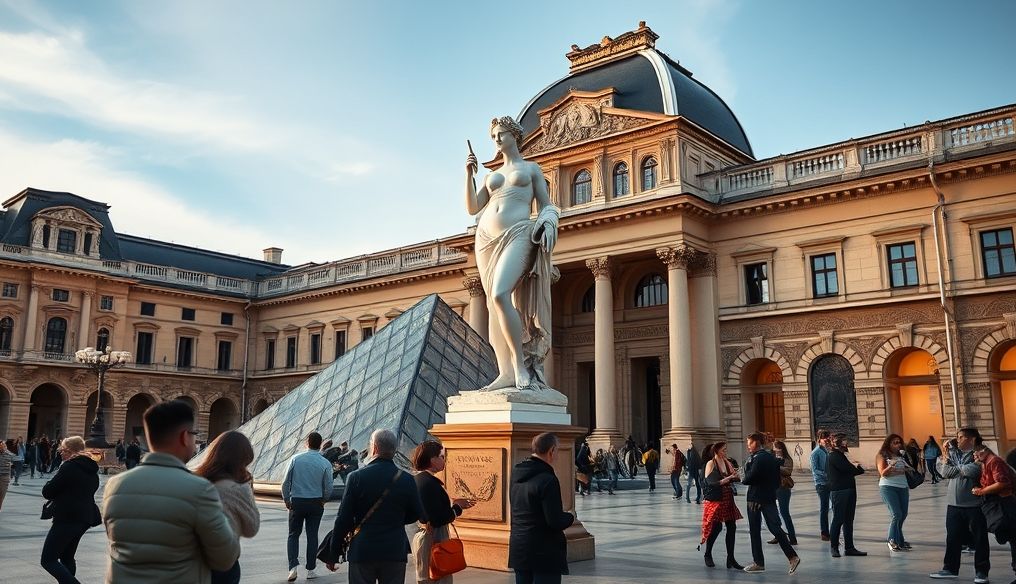What are the Different Types of Plays (Comedy, Tragedy) and How Have They Evolved Throughout History?
Theater is the art of performance that combines literature, acting, and directing to present a story or idea to an audience. Throughout the ages, different types of plays have evolved, each with its unique characteristics and goals. Among the most prominent are comedy and tragedy, which are considered among the oldest and most important theatrical forms.
1. Tragedy: The Human Drama and Struggle Against Fate
Tragedy is a type of play characterized by depicting serious and painful events that lead to a tragic fate for the main character. Tragedy often deals with themes such as death, loss, betrayal, and the conflict between good and evil. Tragedy aims to evoke feelings of fear and pity in the audience, leading to catharsis or emotional release.
1.1 Origins of Tragedy
The origins of tragedy date back to ancient Greece, where it was part of religious rituals in honor of the god Dionysus, the god of wine and fertility. Tragedy gradually evolved from religious songs and chants to integrated theatrical performances. Among the most prominent writers of ancient Greek tragedy are: Aeschylus, Sophocles, and Euripides.
- Aeschylus: Considered the father of Greek tragedy, he introduced the second actor to the play, increasing the possibility of dialogue and dramatic conflict.
- Sophocles: Known for developing the dramatic plot and adding the third actor, which increased the complexity of characters and events. One of his most famous plays is "Oedipus Rex."
- Euripides: Distinguished by portraying strong and rebellious female characters, he also addressed sensitive social and political issues in his plays.
1.2 Characteristics of Tragedy
Tragedy is characterized by several essential features, including:
- Main Character: The main character in a tragedy is often a noble or socially prominent figure, but suffers from a flaw or mistake that leads to their downfall.
- Conflict: Tragedy includes an internal or external conflict faced by the main character, often with fate, evil forces, or society.
- Inevitable Fate: The fate of the main character in a tragedy is often inevitable, and they cannot escape it.
- Catharsis: Tragedy aims to evoke feelings of fear and pity in the audience, leading to catharsis and the release of negative emotions.
1.3 Examples of Tragedy
Some of the most famous examples of tragedy include:
- Oedipus Rex (Sophocles): The story of King Oedipus who discovers that he killed his father and married his mother, leading to his suicide and the collapse of his life.
- Hamlet (Shakespeare): The story of Prince Hamlet who seeks revenge for his father's murder, but falls victim to betrayal and conspiracies.
- Othello (Shakespeare): The story of General Othello who falls victim to destructive jealousy, leading to his murder of his wife Desdemona.
2. Comedy: A Mirror of Society and a Window to Laughter
Comedy is a type of play that aims to evoke laughter and joy in the audience. Comedy often deals with light and humorous themes, using humor and satire to highlight the flaws of society and human errors. Comedy aims to entertain, but it may also carry social or political messages.
2.1 Origins of Comedy
The origins of comedy also date back to ancient Greece, where it was part of religious celebrations in honor of the god Dionysus. Comedy gradually evolved from cheerful songs and dances to integrated theatrical performances. Among the most prominent writers of ancient Greek comedy is Aristophanes.
- Aristophanes: Considered the father of Greek comedy, he was famous for his satirical plays that criticize politics and society. Some of his most famous plays are "The Clouds" and "The Birds."
2.2 Types of Comedy
There are various types of comedy, including:
- Farce: Relies on funny and exaggerated situations, often involving misunderstandings and comedic errors.
- Romantic Comedy: Revolves around a love story between two people, involving funny situations and obstacles in their path.
- Social Comedy: Highlights the flaws of society and human errors in a satirical and humorous way.
- Black Comedy: Deals with serious and painful themes in a funny and satirical way.
2.3 Characteristics of Comedy
Comedy is characterized by several essential features, including:
- Funny Characters: The characters in comedy are often eccentric or have funny behaviors.
- Funny Situations: Comedy includes unexpected and funny situations that evoke laughter in the audience.
- Satire: Comedy uses satire to highlight the flaws of society and human errors.
- Happy Ending: Comedy often ends with a happy ending, where problems are solved and happiness is achieved for the main characters.
2.4 Examples of Comedy
Some of the most famous examples of comedy include:
- A Midsummer Night's Dream (Shakespeare): A complex love story involving fairies, nymphs, and an enchanted forest.
- The Merchant of Venice (Shakespeare): The story of a Jewish merchant who seeks revenge on his rivals, but things end in a funny way.
- The Miser (Molière): The story of a miser who prefers money to everything, leading to funny situations and misunderstandings.
3. Evolution of Plays Throughout History
Plays have evolved throughout history, influenced by the social, political, and cultural conditions of each era. In the Middle Ages, religious plays were dominant, depicting stories from the Bible. In the Renaissance, interest in classical Greek and Roman plays returned, and great playwrights such as Shakespeare and Molière emerged. In the modern era, new types of plays have evolved, such as absurdist theater and political theater.
3.1 Theater in the Middle Ages
In the Middle Ages, the church dominated cultural life, and religious plays were dominant. These plays depicted stories from the Bible and aimed to educate people and raise awareness of religion. Some of the most famous types of religious plays in the Middle Ages are miracle plays and passion plays.
3.2 Theater in the Renaissance
In the Renaissance, interest in classical Greek and Roman plays returned, and great playwrights such as Shakespeare and Molière emerged. Renaissance plays were characterized by complexity and depth, addressing diverse human, social, and political themes.
3.3 Theater in the Modern Era
In the modern era, new types of plays have evolved, such as absurdist theater and political theater. Absurdist theater was characterized by depicting the world as a meaningless world, highlighting the absurdity and irrationality of life. Political theater aimed to raise political awareness among the audience and to criticize injustice and tyranny.
4. Impact of Plays on the Audience
Plays have a significant impact on the audience, as they can evoke their emotions, change their ideas, and inspire them. Plays can help people understand themselves and the world around them, and they can contribute to the development of society and change it for the better.
4.1 Emotional Impact
Plays can evoke strong emotions in the audience, such as joy, sadness, fear, anger, and love. These emotions can help people express themselves and deal with their feelings in a healthy way.
4.2 Intellectual Impact
Plays can change people's ideas and beliefs, and help them see the world from a different perspective. Plays can raise important questions and encourage people to think critically and analytically.
4.3 Social Impact
Plays can contribute to the development of society and change it for the better. Plays can highlight social problems and encourage people to work to solve them. Plays can also promote understanding and tolerance between people and contribute to building a more just and equal society.
5. Theater Today: Continued Creativity and Renewal
Theater continues to play an important role in cultural life today, as writers, directors, and actors continue to create and innovate. New types of plays are constantly emerging, and new techniques are used in theatrical performances. Theater remains a place for self-expression, for thinking about the world, and for connecting with others.
6. How to Choose the Right Play for You?
With such a wide variety of types of plays, it can be difficult to choose the right play for you. Here are some tips that may help:
- Think about your interests: What topics interest you? Do you prefer comedy or tragedy?
- Read reviews: Look for reviews of plays you are considering watching.
- Ask your friends: Ask your friends who like theater to recommend plays.
- Try something new: Don't be afraid to try new types of plays.
7. The Future of Theater
The future of theater looks bright, as it continues to evolve and adapt to changes in society. Theater is expected to see more innovation and experimentation in the future, and to use new technologies to deliver more interactive and immersive theatrical performances.
8. Conclusion
Theater is an ancient and diverse art form that offers us a window into the world and ourselves. Through comedy and tragedy, and other types of plays, we can laugh and cry, think and reflect, and learn and grow. Whether you are a seasoned theater lover or a beginner, there is always a play waiting for you to discover.




